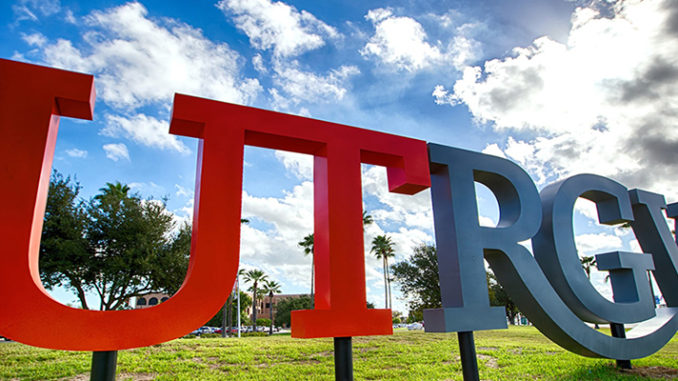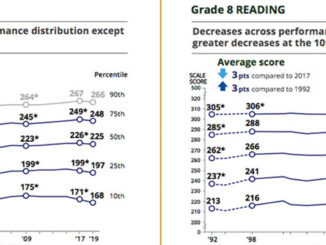
by Richard Whitmire
To put this simply, a breakthrough is not possible without first democratizing higher education. By that I mean making college part of the expected-to-happen fabric of American life for all students, not just the students from well-off families. So what needs to take place to achieve it?
For starters, it means a change in mindset — recognizing that college is the new high school and that jobs that never before required a college degree now do, a phenomenon called college inflation or degree inflation. One study in 2015 from the Harvard Business School found that 67 percent of production supervisor job postings asked for college degrees — despite that only 16 percent of those who held the job at the time had a degree.
Scores of jobs, ranging from bank tellers to the rental car workers who hand over your keys, have been subject to this inflation. Employers now assume that those renting a car expect to find a “professional” behind that counter, meaning someone with peer-like social skills. So they ask for college degrees, a rough guarantee that those abilities have been acquired. No wonder the need to earn a college degree has broadened.
There are some nascent signs that this trend may be turning around, that corporations are open to hiring non–degree earners for jobs that clearly don’t require one — Starbucks supervisor and Apple store “Genius” are two examples — but change is very slow. For the most part, and for years to come, there’s no denying that college truly is the new high school for a vast number of American students who will end up in middle-income jobs.
It also means giving every student a high school education that’s academically rigorous enough to avoid enduring classroom shock when exposed to college coursework. College “unreadiness” is a story that plays out in every state, with startling rates of unpreparedness in California, where more than half of high school graduates fail to meet the minimum requirements for the state universities. But let’s offer some quick examples from a state not normally associated with that problem, New York. The odds of a student in the well-off suburbs going to a high school offering either International Baccalaureate or six or more Advanced Placement courses are better than 90 percent. But in New York City, whose 1.1 million public school students are more likely to be poor and minority, those odds shrink to 18 percent.
It means everyone — students, parents, and colleges — should stop measuring a college’s status based on how few students it lets in and shift to a model based on inclusivity. The aversion top colleges and universities exhibit toward taking transfer students, especially from community colleges, represents the worst kind of elitism.
It means financing education for low-income students to the extent that one car repair doesn’t force them to drop out. KIPP’s 2017 survey of its alumni revealed the extent of the problem: Nearly 60 percent of its alumni worry about running out of food, and more than 40 percent said they missed meals to pay for books, school fees, and other expenses.
It means embracing the fact that college students of today are not the college students of yesterday. In 2015, the Georgetown Center on Education and the Workforce released “Learning While Earning,” which laid out the new reality: About 14 million college students are working, with 70 percent of college students taking time away from college work to earn a paycheck. In fact, U.S. students spend far more time working than in classrooms or studying. And yet few can work their way through college. Even if a student worked full time at the federal minimum wage, that student would earn $15,080 annually. “Even if you work, you have to take out loans and take on debt,” said Anthony Carnevale, director of the center.
What’s needed, said report co-author Nicole Smith, is a tighter connection between work and learning. “When students pick a major or field of study, they need to be told up front what kind of career it likely leads to and how much money they are likely to make, especially if they have to pay back student loans.” In 2018, the center updated the report to focus on how this disproportionately affects minority students.
It means counseling high school students to avoid college dropout factories, which are usually commuter universities with awful success rates. Nationally, the student-to-adviser ratio in high school is 482 to 1, and that doesn’t account for the fact that most counselors have little time, and usually no training, to perform actual college advising. That lack of smart college guidance dooms thousands of students, thus perpetuating economic inequities. Like it or not, a degree appears to be the surest glide path to economic mobility. When a child born in the bottom fifth of the country’s income distribution earns a college degree, their chances of making it to the top quintile nearly quadruple.
It means finding ways to make first-generation students feel welcome their freshman year rather than like strangers afloat in a sea of wealth. When interviewing the KIPP Gaston students from the Class of 2009, I was struck by the college shock nearly all felt after arriving on elite campuses, where most students spent freely and casually exchanged stories about expensive trips taken during school breaks — all while the first-generation students worried about getting bus fare for a trip home over Thanksgiving break. That’s one reason so many of these students retreat to self-isolation on campus and socialize mostly with students like them. When it comes to classroom performance, where collaboration with other students, such as study groups, is essential, that isolation hurts them.
That’s a formidable list, and it might even be considered fanciful except for one thing. There’s a place in the United States where democratization of education has taken hold, and it’s the most unlikely place you can imagine: the Rio Grande Valley in Texas, one of the poorest places in the country.
They said they were crazy: IDEA shoots for 100% college acceptance
To outsiders, the area around McAllen, Texas, is best known for other reasons: It’s ground zero in the immigration wars. This is where Donald Trump wants to build the first part of his new border wall. It’s home to the country’s largest immigration detention center, the place where children infamously got separated from their parents. But there’s another story playing out here. McAllen is also home to IDEA Public Charter Schools, a fast-growing charter network with ambitions that extend far beyond providing good K-12 schools. IDEA wants to democratize higher education, making it routine for thousands of low-income Hispanic families in the Rio Grande Valley, who never before even considered college. Based on my visits there, they are well on their way.
When IDEA founders Tom Torkelson and JoAnn Gama, both Teach for America teachers sent to the region (Tom, a student at Georgetown University, says he had trouble finding the place on a map), launched their first charter school in 2000 in Donna, the school was only grades 4-8, but the goal was always college: All our students will go to college. At that time, in a region where few of the low-income Hispanic students even thought college was a possibility, that promise couldn’t pass a laugh test. “Everyone thought they were crazy,” said Phillip Garza, who today oversees college programs for IDEA. “They said there was no way they could do it. But they had the courage and fortitude to get it done, and they delivered. For the last 12 years, 100 percent of our graduates have been accepted to college, and all but four students have gone.”
Today, when driving through the region, it’s not hard to spot billboards paid for by local school districts vowing that schools are all about “preparing students for college and careers.” That’s the impact IDEA has had in the Valley since 2000, said Garza. “Now, at all these districts, high school graduation alone is no longer the expectation.” That’s democratizing higher education. What this means on the ground is best viewed at the student level. Many middle-class suburban families might take one look at their stories and come to a quick judgment: These students are not college material. But that’s not how IDEA sees them, and now it’s not how the students see themselves
Consider Ricardo Murillo, whose parents were deported to Mexico when he was 11. At the time, they were living in Edinburg, just outside McAllen. His mother sold ice cream; his father did everything from cutting grass to working as a handyman. His entire family moved back to Mexico, but when he was 13, Murillo — the only one born in the U.S. — concluded his future was brighter in the United States and returned to Texas, living with cousins outside Edinburg. After spending a summer in Mexico with his parents, he went back to Texas to learn that his cousins were transferring to an IDEA charter, and therefore he had to as well.
“I was pretty angry. IDEA was becoming a popular school, but it was not what I wanted. I thought it was a nerdy school.” What Murillo wanted was to stay at his traditional public school in Donna, where, by his own description, he was becoming a “baggy” — a term for gang members and their baggy clothes. But he had no choice, so he entered IDEA Alamo. There, his grades ranged from C’s to A’s, depending on the course. It wasn’t until his senior year that he even considered college, a must-do at IDEA.
Murillo ended up at the University of Texas Rio Grande Valley in Edinburg, best described as a commuter university. It’s a choice embraced by many IDEA graduates, either because of middling grade point averages and test scores, a desire to live at home with family, or both. But UTRGV, as it is known locally, is a cut above the average commuter university. Torkelson sits on the board, and IDEA keeps two college counselors on campus just to guide its students.
The college success rate there — 40 percent of the entering freshmen earn a bachelor’s degree within six years — is well below those of elite colleges and universities with success rates hitting the 90 percent mark. But that 40 percent is double what you find at many commuter universities, and IDEA’s involvement probably has a lot to do with that.
Murillo still lives with a cousin, and he works at the homework center at an IDEA school, helping high school students with their studies. Despite his spotty record in middle school and high school, Murillo stepped it up in college, tackling a challenging electrical engineering major. He’s on track to graduate in five years. With Pell Grants and scholarships, he will owe only about $4,000 after leaving college. After graduation, he’s looking at two careers — taking a job at a robotics company or working as a school counselor at an IDEA school.
“An assistant principal at IDEA Alamo said I would make a great counselor, telling students about my background, how I made it,” he said.
And then there’s Juan Reyes, whose family has struggled with finances. He grew up in McAllen, then Pharr. His father worked as a furniture company driver, but the company went out of business. “He has diabetes, so it’s hard to find work,” Juan explains. His mother has always been a stay-at-home mom. Reyes went to district schools until ninth grade, when he switched to IDEA San Juan. “My parents didn’t want me to go to [the local high school]. It was too violent, a lot of kids fighting.”
At IDEA, the academic challenge was different. “At my neighborhood school, the teachers didn’t care if you did the work. At IDEA, the teachers care. If you don’t do the work, it’s like you are hurting them.” Reyes was a good student, not great. When it came time to choose a college — something that in earlier years had been hard to imagine — he also chose the University of Texas Rio Grande Valley. “My family was struggling, and Hispanic families are very close. When one member of the family leaves, everyone is sad. So it would have been hard for me to leave.”
Much like Murillo, when Reyes got to UTRGV he stepped it up, enrolling in the accounting program. He has nearly a 3.0 grade point average, and in the summer of 2018, he was only one course away from graduation. He will leave with about $8,000 in college debt. His goal: a master’s degree in accounting and a job as an accountant at a university.
Both Murillo and Reyes represent what’s happening in the Rio Grande Valley, courtesy of IDEA charters. Yes, IDEA sends a fair number of its graduates to the more prestigious University of Texas at Austin and Texas A&M and a sprinkling to the Ivies and other top Eastern universities (my personal favorite: several years ago, when watching a raucous college signing day at a local arena, I saw Gilberto Gutierrez celebrate his acceptance at MIT. His mother works at an IDEA school cafeteria). But that’s not really what democratization of higher education is all about. What democratization does mean is that over the past 12 years, as Garza points out, 100 percent of IDEA’s students have been accepted to colleges, and all but four have gone, thanks in part to universities such as UTRGV.
The question to ask, of course, is: Are they successful? Do they earn degrees? Over those 12 years, roughly 44 percent of IDEA graduates ended up with bachelor’s degrees. For comparison purposes, roughly 11 percent of low-income students do the same. Even more interesting: Like other charter networks, IDEA tracks its graduates by cohorts. For the more recent Class of 2012, the projection shows that 55 percent are on track to earn a bachelor’s within six years, the highest in the network’s history.
Should IDEA worry that so many of its graduates end up at UTRGV? That question gets at the heart of what democratization of education means. Garza loves to cite the number of graduates who go off to prestigious colleges, where the likelihood of earning degrees is near certainty. But he also knows his IDEA families, who struggle with financial issues and grapple even more with seeing any of their children leave town. “College is an academic decision, but it’s also a fiscal decision and a social decision,” said Garza. “We are in the business of ‘me power’ … We want to give families choices.” And if they choose to stay close to home and graduate nearly debt-free, so be it. It was an informed choice.
IDEA’s push for the democratization of higher education extends to gathering up students who “stopped out” of college and want another shot. In what is called IDEA-U, students sign up for the online curriculum offered by College for America at Southern New Hampshire University. But instead of a problematic do-it-alone-at-home online program, IDEA-U offers an actual classroom building complete with a tutor/counselor. Not only can the students escape home distractions, but they have the kind of education technology, including computers, that aren’t found in their homes. The tuition is $5,500 a year, which matches a Pell Grant, and IDEA predicts that most of its students will complete an associate’s degree in eight to 14 months.
What makes the College for America program work for low-income students, said Paul LeBlanc, president of Southern New Hampshire University, is that it’s competency-based. Mastering the content is what counts, he said, not mastering the content in a prescribed period of time, which is the way most colleges operate. “When a student’s daughter has a bout of illness, they can just stop out. There’s no penalty for hitting the pause button. When they are ready to begin again, they hit the start button.”
The coaches based at IDEA-U are about more than academics, said LeBlanc. “They are life coaches. If you are poor, society is sending you signals all day long that you don’t matter very much. Because if you did matter, you would have a decent grocery store in your neighborhood. If you did matter, people would care more about the plight of the poor in America.”
The coaches and the academic center offer a sense of belonging, a sense that you do matter — a sentiment these students rarely feel, said LeBlanc. “It’s no surprise kids join gangs. The gangs tell them that you matter so much they would kill for you. It’s a signal that you matter, that you belong.” The coaches, said LeBlanc, are always talking to the students. “They’re asking about their learning, how things are at home, how they did on that last project. And the students think, ‘Oh, wow, somebody cares that I’m doing this.”
IDEA-U opened in 2017 with 100 students. The goal: 6,000 students in six years with multiple centers. A fanciful goal, perhaps, for anyone other than IDEA, but this is the fastest-growing charter network in the country, and it has always met its expansion plan. Currently, IDEA has 79 schools with 48,000 students and aims to have 100,000 students in 200 schools by the year 2022.
IDEA offers an insight into Phase Two of The B.A. Breakthrough. Phase One was the push to do right by students who are talented but poor, those who graduate at the top of their high school classes, test well, but rarely make it to a college that’s their equal, a college from which they are likely to graduate. The Jack Kent Cooke Foundation, which seeks out these students for scholarships, estimates there are 3.4 million high-ability, low-income students in grades K-12. That’s a lot, and the foundation deserves thanks for its pioneering work. But all those talented kids have siblings and neighborhood friends who attend school with them. Reaching all those students and finding a college pathway for all of them, not just the very brightest, is what IDEA and other charters do. That’s Phase Two of the Breakthrough.
Nobody believed Tom Torkelson and JoAnn Gama when they opened their first charter and promised college for all. Not only have they done that with their own alumni, but they forced the traditional school districts in the region to pursue the same college-for-all goal. The Rio Grande Valley is not the only place in the United States where the democratization movement is playing out. California is a close runner-up.
But the Rio Grande Valley may be the only place where you can read all about it on billboards.
Richard Whitmire is the author of several books, most recently “The B.A. Breakthrough: How Ending Diploma Disparities Can Change the Face of America.” Whitmire is a member of the Journalism Advisory Board of The 74.
This is an excerpt from the new Richard Whitmire book The B.A. Breakthrough: How Ending Diploma Disparities Can Change the Face of America. See more excerpts, profiles, commentaries, videos, and additional data behind the book at The74Million.org/Breakthrough.



